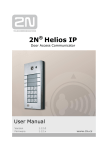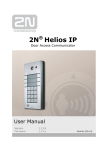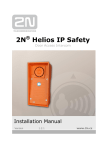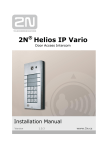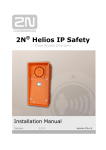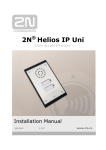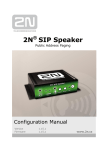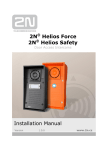Download 2N ® Helios IP Manager
Transcript
® 2N Helios IP Manager 2N® Helios IP Door Intercom Configuring and Administering Software User Manual Version Software 1.3.0 1.3.x www.2n.cz 2N TELEKOMUNIKACE a.s. is a Czech producer and supplier of telecommunication equipment. The company’s product lines include GSM gates, branch switchboards, and door and lift communicators. For several years, 2N TELEKOMUNIKACE a.s. has been among the 100 best companies in the Czech Republic, and for twenty years it has been a symbol of stability and prosperity on the telecommunication technologies market. Currently, the company exports to over 120 countries around the world and has exclusive distributors on all continents. 2N® is a registered trademark of 2N TELEKOMUNIKACE a.s. The names of its products and any other names mentioned herein are registered trademarks and/or trademarks and/or marks protected by law. 2N TELEKOMUNIKACE a.s. holds an ISO 9001:2000 certificate. All of the company’s development, production, and distribution processes are managed in line with that standard and guarantee the high quality, technical standard, and professionalism of our products. Table of Contents 1. Product Overview............................................................... 5 1.1 Product Description ....................................................................................................... 6 1.2 Associated Products ...................................................................................................... 7 ® Basic 2N Helios IP Units ................................................................................................. 7 1.3 Upgrade ........................................................................................................................... 8 1.4 Terms and Symbols Used ............................................................................................. 9 Symbols Used in Manual .................................................................................................. 9 Future Functions............................................................................................................... 9 2. Software Installation ........................................................ 11 2.1 Minimum System Requirements ................................................................................. 12 2.2 Software Installation .................................................................................................... 13 2.3 Application Licensing .................................................................................................. 14 3. Application Controls ........................................................ 15 3.1 Application Controls .................................................................................................... 16 3.2 Zones ............................................................................................................................. 18 3.3 Devices .......................................................................................................................... 20 Setting Telephone Directory ........................................................................................... 22 Setting Display................................................................................................................ 23 Setting Device ................................................................................................................ 28 3.4 Users .............................................................................................................................. 30 Assigning RFID Card to User ......................................................................................... 31 Assigning User to Group ................................................................................................ 32 Assigning User to Zone .................................................................................................. 33 3.5 User Groups .................................................................................................................. 34 Assigning Users to Group .............................................................................................. 35 Assigning User Group to Zone ....................................................................................... 36 3.6 Time Profiles ................................................................................................................. 37 3.7 Uploading Data to Devices .......................................................................................... 38 3.8 Backing up System Configuration.............................................................................. 39 1 1. Product Overview In this section, we introduce the 2N® Helios IP Manager product, outline its application options and highlight the advantages following from its use. Here is what you can find in this section: Product Description Associated Products Upgrade Terms and Symbols Used 5 Product Description 1.1 1.1 Product Description The 2N® Helios IP Manager application is used for setting up and administering intercoms of the 2N® Helios IP family. The application is intended for the intercoms system administrator and is installed on a computer that has access to the intercoms configured via a LAN network. 6 Associated Products 1.2 1.2 Associated Products Basic 2N® Helios IP Units 9137111(C)E 9137131(C)E 9137161(C)E Basic unit 1 button Basic unit 3 buttons Basic unit 3×2 buttons 9137111(C)KE 9137131(C)KE 9137161(C)KE 9137160(C)KDE Basic unit 1 button + keypad Basic unit 3 buttons + keypad Basic unit 3×2 buttons + keypad Basic unit 3×2 buttons + keypad + display (C) = integrated camera 7 Upgrade 1.3 1.3 Upgrade The manufacturer reserves the right to modify the product otherwise than is shown in the documentation, in order to improve the product’s properties. Version of the manual Description of changes 1.0.0 The Condensed User Manual corresponds to the 2N® Helios IP Manager application with version 1.0.1 1.0.1 The Condensed User Manual corresponds to the 2N® Helios IP Manager application with version 1.3.1 Attention The manufacturer responds to customer demands by continuously improving the software. The current software and the 2N® Helios IP Manager User Manual are available on the www.2n.cz website. 8 Terms and Symbols Used 1.4 1.4 Terms and Symbols Used Symbols Used in Manual Warning Always abide by this information to prevent damage to the device. Attention Important information for system functionality. Tip Useful advice for quick and efficient functionality. Note Routines or advice for efficient use of the device. Future Functions The grey-marked text in this document designates the functions that are under preparation or development at present. 9 2 2. Software Installation This section describes the installation of the 2N® Helios IP Manager software. Here is what you can find in the section: Minimum System Requirements Software Installation Process Application Licensing 11 Minimum System Requirements 2.1 2.1 Minimum System Requirements Minimum Requirements Operating system: Windows XP SP2, Windows Vista, Windows 7 Processor: 1 GHz Operating memory: 512 MB Available disk space: x86 – 900 MB, x64 – 2 GB Display resolution 1024 x 768 pixels Recommended Configuration Operating system: Windows XP SP2, Windows Vista, Windows 7 Processor: 2 GHz Operating memory: 1 GB Available disk space: x86 – 900 MB, x64 – 2 GB Display resolution 1024 x 768 pixels 12 Software Installation 2.2 2.2 Software Installation The 2N® Helios IP Manager application can be found on the enclosed product CD. The most current version can be downloaded from the www.2n.cz website. The application can be installed on a computer featuring a Windows XP, Windows Vista, or Windows 7 operating system. Installation is done by launching the setup.exe file. A security warning (see below) will be displayed during the installation; please accept it by pressing the Install (Instalovat) button. 13 Application Licensing 2.3 2.3 Application Licensing The 2N® Helios IP Manager is supplied as a 30-day demo version. The demo version functionality is limited to up to five devices to be configured within one project. The following licences are available: 9137911 - 5 devices 9137912 - 20 devices 9137913 - 50 devices 9137914 - unlimited A unique PC identifier is required for licence generation. Press the Request new licence button to get the identifier. 14 3 3. Application Controls This section describes the controls of the 2N® Helios IP Manager application Here is what you can find in this section: Basic Controls Creating Zones Adding Devices Creating Users and User Groups Setting Time Profiles Saving Data in Devices Backing Up System Configuration 15 Application Controls 3.1 3.1 Application Controls The application window is divided into several sections (see the figure below). Configuration cards Toolbar List of items Context buttons Tags Toolbar A backup of the configuration of the administered intercoms is saved on the computer of the system administrator as an xml file. That file can be saved, loaded to/from a file, or to any of the intercoms using the toolbar buttons. Save – save a project in a file. Load – load a project from a file. New – set up a new project. Upload – send configuration to selected devices. Tags The configuration of the intercom system is divided into several areas, between which switching is possible, by using the tags in the bottom left hand corner of the application window. Tip Double-click on a tag to display a detailed list of the items (users, zones, devices, etc.). 16 Application Controls 3.1 List of items Displays the objects created (users, zones, devices, etc.) at the tag selected – parts of system configuration. By right-clicking on the item, a context menu can be called up, with an offer of actions related to the item. Context buttons Buttons for the quick manipulation of the object displayed. The number and functions of the buttons depend on the currently chosen tag – part of system configuration. Usually, the following buttons are available: Add or Create – add or create a new item. Delete – delete an item. Configuration cards Configuration cards make the setup of the selected item clearer and well-structured. 17 Zones 3.2 3.2 Zones An area or building entrance that is secured with door intercoms can be divided into so-called zones. Access to those zones can be restricted only to the people on a list. Any number of zones can be defined in the system, and their hierarchies can be set up as required. When setting up a new configuration, at least one zone must always be created. Creating a zone: Go to the item Zones in the tags. Call up the context menu Add root zone in the item list. Enter the zone name. Confirm the zone creation by pressing Create. When creating zone hierarchy, proceed from the highest superior zone. Creating a subordinate zone: Go to the item Zones in the tags. Call up the context menu Add child root zone in the item list. Enter the zone name and choose the Parent Zone. Confirm the zone creation by pressing Create. 18 Zones 3.2 Tip When creating a subordinate zone, the currently selected zone is used as the implicitly set Parent Zone. One or more universal numeric access codes can be assigned to each zone. These access codes can be used for fast and secure access to a zone with intercoms featuring a numeric keypad. The codes entered will apply to all devices in the given zone. 19 Devices 3.3 3.3 Devices Every 2N® Helios IP intercom is represented in the application by a so-called device. A device is defined by its own IP address, communication port and access password. Adding a physical device to system configuration: Go to the item Devices in the tags. Call up the context menu Add new device in the item list. Select a device from the list in the Network Scan window or select manual entering (enter the device name, IP address, access data and 2N® Helios IP type, and select zone). Confirm the creation of a device by pressing Create. 20 Devices 3.3 Note The device name is used for easily distinguishing devices in lists. It has no impact on the functioning of the system and its choice is up to the system administrator. Having created a device, download the device configuration on Settings / Maintenance folder using Download settings from device. Tip In the Offline mode, the application does not communicate with the given device. The function is useful for creating configuration without access to the given device. In the Auto refresh mode, information on the device is updated on-line. Disable the function to restrict current communication between the application and the intercoms via the network. 21 Devices 3.3 Setting Telephone Directory On the Phone Book folder, you can set the users to be called from the selected device with the quick (speed) dial buttons. Logical Folder Use the folder to assign users to telephone directory positions. Click on the … button and select a user from the list to assign a user. Note The number of telephone directory positions depends on the model and licence of the given device. Tip Configuring the telephone directory, consider the planned application of 2N® Helios IP and extending button modules (extenders). The first six telephone directory positions is used for the 2N® Helios IP buttons and positions 7 – 54 are assigned to the extenders. 22 Devices 3.3 Physical Folder Use the folder to assign users to speed dial buttons. To add the extenders and info panel, right click on the lower 2N® Helios IP image and select the type in the context menu. Use the Display folder on the main folder to set speed dialling for the display equipped models. Setting Display Use the Display folder to set the information to be displayed on 2N® Helios IP. Use the folders below to set the display parameters. Theme Folder Use the folder to set the colours for status screen elements displayed during calls and at relax. Also set the default colour layout and font for the telephone directory items to be displayed. 23 Devices 3.3 Localisation Folder Use the folder to set the button tags and status reports to be displayed on 2N® Helios IP. 24 Devices 3.3 Phonebook Folder Use the folder to create the telephone directory to be displayed on 2N® Helios IP. Add users and user groups to the telephone directory structure. Set the colour scheme and font for each item. Select Theme before adding an item to the telephone directory for bulk setting. Use the content menu displayed by the right-hand mouse button to arrange and remove items. A group is processed as a single item containing users assigned to the given user group. The list is updated after every change and new users are added tom the end of the group. Arrange the group users alphabetically in the context menu. Name Tags Folder Use the folder to assign users to the speed dial buttons and information to be displayed on the display equipped 2N® Helios IP models. Either set the name tags in the application, or use an image of your own for the background depending on the selected layout type. Layout types: Single – one item Double (horizontal) – two items Quadruple – four items Custom – four items, own background image 25 Devices 3.3 In the Custom layout, press Change Image and add an image in the features. The recommended image size is 320 x 208 pixels. A different size will be adjusted automatically. 26 Devices 3.3 Adverts Folder 2N® Helios IP allows you to display a set of selected images at idle time. Add any image from your PC to the list, such as your company logo, opening hours or advertisements. Use an image of the size of 320 x 240 pixels to avoid automatic size adjustment. Select the image switching time for each image. 27 Devices 3.3 Setting Device Use the Settings folder to set all of the 2N® Helios IP parameters. Refer to the 2N® Helios IP Configuration Manual for parameter details. Click on Download settings from device on the Maintenance folder to load the configurations into the application. Attention Before loading a configuration into a device, we recommend you to make sure that the network parameter settings are correct. Bulk Parameter Configuration Use the Bulk Edit mode for bulk configuration of parameters for multiple devices. Click on the Bulk Edit context menu in the list of items. Tick off the box in front of the item name to select the device to be configured. The values of the parameters on a white background are identical for all the selected devices. Grey-highlighted parameters are different for different devices and their values are not displayed. Once set, the value of the grey highlighted parameter will be saved into all the selected devices. Click on the Cancel Bulk Edit button above the item list to quit the Bulk Edit mode. 28 Devices 3.3 Tip The Bulk Edit mode facilitates setting of the parameters that are identical for more devices than one. 29 Users 3.4 3.4 Users A system user is an individual using the intercom system. A system user may have access to a zone or may be available on a quick dial button (name tag) of any intercom in the system. Creating a user: Go to the item Users in the tags. Call up the context menu Add new user in the item list. Call up the name and abbreviated name of the user. If required, enter the activation codes and set up a photo. Confirm the user creation by pressing Create. One or more telephone numbers can be assigned to each user and a substitute whom the intercom will call if the user is unavailable. The address of the computer (Station Address) on which the HipEye application has been installed can be entered. Tip Users can be grouped in user groups that serve for setting up batch access rights for several users simultaneously – refer to Section 3.5. 30 Users 3.4 Assigning RFID Card to User RFID cards are used for identifying a user in the system. One or more RFID cards can be assigned to a user. The user RFID cards are edited on each user’s Cards folder. Creating a user card using a USB card reader (Part No. 9137420E) connected to the PC: Press Create card. Press the green button behind the Identification box. Hold the card to the reader (the card number will be filled in including prefix 1*). Confirm the card creation by pressing Create. Creating a user card by reading a card in the intercom: Read the card in the terminal and find its number in the web configuration interface, Card reader / Access log menu. Press Create card. Fill in the card number including prefix 0*. Confirm the creation of the card by pressing Create. 31 Users 3.4 Assigning User to Group On the Groups folder, users can be assigned to one or several user groups. User groups are used for the batch setup of access rights simultaneously for several users. A user is assigned to a group by checking off the box in front of the name of the relevant group. 32 Users 3.4 Assigning User to Zone On the Zones folder, user access rights to individual zones are defined. Access to a zone is permitted by checking off a button after the name of the relevant zone. If access to a zone is permitted, the zone is shaded in green. If a zone is shaded in green even without the box being checked off, the user has access to the given zone permitted due to his membership in a given user group that has access to that zone. 33 User Groups 3.5 3.5 User Groups Users of the 2N® Helios IP intercom system can be divided into user groups. Those user groups allow for the easier batch assignment of access rights to a greater number of users. When establishing a new configuration, you are recommended to create one user group at least. Creating a user group: Go to the item User Groups in the tags. Call up the context menu Create group in the item list. Enter the user group name. Confirm the user group creation by pressing Create. 34 User Groups 3.5 Assigning Users to Group On the Users folder, users can be added to or removed from a user group. The list on the left shows the selected users and the list on the right shows the remaining users who are not assigned to this group. Users can be moved by the arrow buttons placed between the lists. 35 User Groups 3.5 Assigning User Group to Zone On the Zones folder, access to one or several zones can be set for selected user groups. All users from that group will then have access to the zones selected. Access to a zone is set up by checking off the button behind the zone name – the accessible zone is then marked in green. 36 Time Profiles 3.6 3.6 Time Profiles Time profiles help limit the functionality or validity of some of the functions of the 2N® Helios IP intercom. With time profiles, you can manage the validity of telephone numbers, lock codes, RFID cards, etc. Creating a time profile: Go to the item Time Profiles in the tags. Call up the context menu Create time profile in the list of items. Enter the time profile name, the term of application and any activation codes. Confirm the time profile creation by pressing Create. 37 Uploading Data to Devices 3.7 3.7 Uploading Data to Devices If you want the changes you made in the system configuration to be reflected in the functioning of the administered intercoms, you need to send the current configuration to them. The button Upload in the button bar is used for sending configurations to devices. A user simply chooses the devices to which the configuration will be sent by checking off boxes in a list of devices. Uploading data to devices: Double-click on the Devices tag. Check off all of the devices to which the configuration is to be sent. Press the Upload button on the button bar. Note Before sending a configuration to the devices, make sure that the network parameters have been set up correctly. 38 Backing up System Configuration 3.8 3.8 Backing up System Configuration System configuration is stored on the administrator’s computer in the form of a configuration file (xml). The current configuration can be saved on the computer disk by pressing Save and loaded with the Load button in the toolbar. Attention The configuration of the system cannot be fully reproduced by loading data from each device. The complete system configuration is only saved in the configuration file on the computer of the system administrator. The configuration file is required for modifying system settings in the future; make sure you have backed it up properly. 39








































